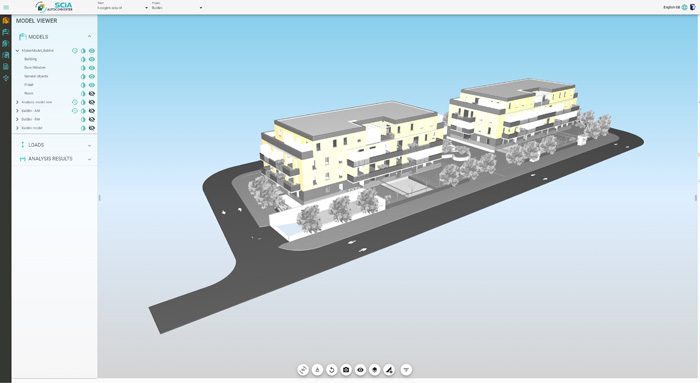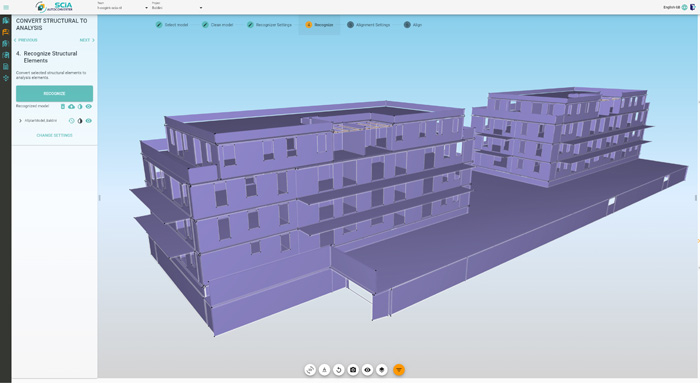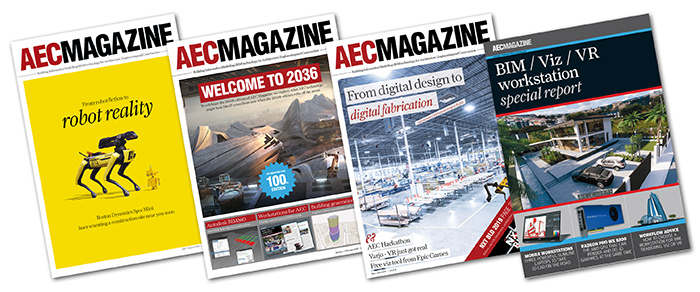Nemetschek Group, perhaps best known for its architectural BIM brands, is looking to leverage SCIA and Allplan to move away from manual processes and to drive integrated digital workflows for structural design, writes Martyn Day
Nemetschek occupies a unique position in the BIM market. It is an AEC-focussed holding company which owns no less than three global BIM brands: Vectorworks, Graphisoft and Allplan, as well as thirteen other industry-related companies which are driving the digitisation of many different aspects of the construction industry. With the launch of ArchiCAD 24 earlier this year, Graphisoft introduced a file-less and instant workflow between architectural BIM tool ArchiCAD and multi-material structural analysis software SCIA Engineer, as well as a new open format (structural analysis format — SAF). It was clear that Nemetschek was looking to extend its focus beyond architecture to improve digital workflows for other industry disciplines, as well as connecting up its own technologies.
In truth, Nemetschek through its Allplan brand, has always been in the construction side of BIM, but the company’s past lack of integration between its brands and technology, has tended to keep Allplan to its core geographies, namely Germany, Austria and Switzerland (the DACH region). Now a broader vision is emerging from Nemetschek’s Bavarian HQ which will enable technology from its brands to play better together and it’s mainly thanks to the smart use of the cloud.
While Nemetschek has not gone down the route of creating suites of products (like Autodesk Collections), it has opted to work on filling in the digital divide that exists between the various disciplines in federated projects and different applications. Much of this is driven through the company’s adherence to IFC and OpenBIM and core benefits of cloudbased workflows. This approach helps it connect applications within its own ecosystem and ultimately plays well with the fact that, in the real world, applications used in any one project don’t come from one single vendor.
AEC Magazine caught up with Nigel Rees, business strategy manager at Allplan and Viktor Varkonyi chief division officer at Nemetschek Group to discuss Allplan’s BIMplus platform, along with SCIA AutoConverter which can automatically convert any structural model from any CAD system into an analysis model in an OpenBIM workflow.


Nigel Rees: Before I started with Nemetschek, the way structural engineers work is a very manual processes, which potentially means data is lost along the way — or, because it’s a manual process, you get people recreating what someone else has already modelled. Over the last 20 years, people have been trying to do this, but never really convinced the engineering profession that they needed to change, because there was always an element of manual rework. We recognised that there was an opportunity to do things better for engineering, in particular, the civil and structural engineering profession.
So how do you do that? Technically we’re in a fairly fortunate time at the moment with cloud technology, with algorithms and cloud being more accepted in the industry. We thought, a very nice and very effective workflow for engineers would be if we could have all the data in one place. We can take it from anywhere, and we don’t care where it comes from.
BIMplus is a data environment which can deal with the federated model. We can pull data in from all the CAD and 3D modelling systems within the group (Nemetschek) or outside group — it doesn’t matter where it comes from.
Our job within BIMplus is to actually neutralise that ‘file’ problem and democratise that data. We can bring in a model, or part of a model from Allplan, Revit, or from ArchiCAD. From an IFC perspective, we join it all together in BIMplus, and it is representative of the 3D model in any one of those BIM programs. We then send it to AutoConverter.
AutoConverter
The SCIA AutoConverter is a plug-in for BIMplus that can convert any imported structural model from any CAD system, into an analysis model without having to start the model from scratch, using a controlled, automated process that applies recognition algorithms to the data.

The combination offers integrated change management and revisioning. Adjustments made to the structural model are then automatically updated to the related analysis model without the loss of data, such as loads. This drastically reduces the time spent on rework.
Nigel Rees: In its simplest form, if you think of a column and a beam intersection, a [simple CAD] system doesn’t know that it’s a column or a beam, it just happens to be ‘something vertical’, ‘something horizontal’. [Using SCIA AutoConverter] we walk around the perimeter of that section — that could be an I-section, could be a square or whatever it may be — and the algorithm recognises it. The system then stores that information and associates that with a database of sections.
After it has analysed the whole model, it goes from a state of dumb geometry to an engineering model and because it knows it’s an I-section or a rectangular section, it can do the alignment. It then does another pass over the model and it looks at offsets to beams onto the base of the column, for example, or it may need to shift it up to the surface/ floor plate.
At that point, the engineer can enter into a process that they’re familiar with. They can either take control of that analytical model themselves and really drill down to where they’re concerned about the master lines. Or they can click the button and have AutoConverter do it all for them. For simple to medium complexity structures, that’s often good enough, but for more complex structures, it’s important that the engineer can take control.
The important thing is that we don’t just keep that in as data for our own tools, we allow that to go to any structural analysis tool. So yes, you can use SCIA and AutoConverter but it can also go to any other structural analysis system.
AEC Magazine: How accurate is SCIA AutoConverter?
Viktor Varkonyi: I think it’s a balance of the quality of data that is flowing in.
Nigel Rees: The quality of the model coming into BIMplus is critical. If it’s a real jumbled-up mess coming in, then you would get the same issues using AutoConverter that you’d have anywhere else. AutoConverter would do a lot of the cleanup for you in the first pass over the model, but every engineer needs to do a manual check on the data that they are sending through, such is the critical nature of that data. Downstream you always have to do an initial run on your analysis to check whether this is working. That’s just due diligence on the engineering side. Actually, if you click a button on AutoConverter it will join everything together with hundred percent right, but the question always is – is that what the engineer wants? We introduced many controls into AutoConverter, because the engineers are not comfortable with just clicking a button because then it becomes a black box and we wanted to steer away from ‘black box’ solutions. It needs to be open, it needs to be configurable, and it needs to be editable for engineers.
The thing about passing information through the analysis tools, is that there are so many different types of analysis and use cases where a linear static model is, by definition, different to a dynamic model. You need different components acting in different ways, if you’re going to do a dynamic model analysis. Effectively, you end up with two completely different models. But in terms of ‘does a column connect up to a beam?’ Yes, AutoConverter does that 100%.
I think this is new to the engineering process. What people are realising at the moment is that they can actually create models a lot quicker now, than they were [previously] able to. Look at model creation, what would have typically taken two to three days in the past, now it can be done in minutes – literally ten to fifteen minutes to get that geometry pass through.

What this enables the engineer to do is a lot more of the optioneering — what if we changed part of the model to steel, what if we did it in timber? And then presenting those options back to the client. Maybe it’s still a linear workflow from that perspective, but the fact that they can bring different options and cost benefits to the client that they were too time constrained to do before [is a big benefit].
For this all to work, it’s very important that you can actually do version control. Every iteration that comes into BIMplus has a version against it. One of the things early adopters liked about the version control is that we stored every iteration of that structural analysis in BIMplus, so clients can see what work has been done. Not only does it provide that speed, it actually allows engineers to get the validation process for the client.
BIMplus and AutoConverter speeds up the process while minimising the errors. A traditional workflow may have someone building a model, and then you have the engineer reading that model or visually inspecting it and then recreating it in another tool. It may also then be the case that you need to go from one structural analysis tool to another to perform different types of analysis, e.g. linear static or dynamic analysis. With BIMplus and AutoConverter you can now push that from one centralised managed environment to different analysis tools with no data loss.
SAF Files
Nigel Rees: The other part of the project was to develop a neutral file format which anyone can read. We came up with a concept we called SAF (structural analysis format), which actually writes data into an Excel format. The reason why we did that is because virtually every engineer is going to have a copy of Excel on their desk It can then be hooked up to products like Robot, Staad and any other analysis tool like Frilo from the Nemetschek Group as well.
When we send the data out of this managed BIM environment, it exists in multiple forms, in the various structural analysis tools, but now we actually have a system that can bring back that data into the managed environment. So that’s where we differ a little bit as we are sending data out, but actually bringing it back in and managing it again. It’s managed, to unmanaged, and back into managed again. That gives us an edge, certainly in the structural engineering world because once it comes back into BIMplus, then you don’t just have the geometry model anymore, you have multiple versions of the analysis model, sitting within that BIM environment.
Cloud strategy
AEC Magazine: With BIMcloud for ArchiCAD, BIMPlus for construction, and BlueBeam Studio, is there a single cloud strategy for Nemetschek?
Viktor Varkonyi: Obviously, the Graphisoft ecosystem and the Allplan ecosystem are serving slightly different customer profiles and customer segments. Graphisoft has strengths early in the design process, in very iterative workfows, while the design is still very agile in the architectural processes. Allplan is a little bit later in the process. BIMplus is software agnostic and based on IFC open standards. We have a lot of projects where AutoCAD customers are sharing IFC files to BIMplus and then Allplan is using AutoConverter.
The Nemetschek strategy is that we are building these solutions together, but keep the innovation very close to the market with that brands having focus on certain markets.
For the Nemetschek Group, cloud is not ‘the goal’. I think companies that make going to the cloud a goal are too financially driven. For Nemetschek it’s about the deployed cloud when it delivers some customer value. With BIMplus, being in the cloud, it’s to liberate data access, in any form. That’s a real and definite customer value. This is why BIMplus is cloud-based and based on open standards. Actually, I think this is one of the only platforms out there that internally uses open standards as the core data structure. So, we are not converting data. On top of that, we have a powerful API, again, liberating data access but, as Nigel mentioned, the complex functionality that SCIA AutoConverter is doing is also fully built on public API services. So, I think that gives you the impression of strengths that how powerful the system is.
On the analysis solution, the Nemetschek strategy for the cloud is that we have put a strong focus to build our data structures into the cloud, this is what BIMplus is doing in the open engineering environment. This is what Graphisoft is doing with BIMcloud, for the building design space, also what BlueBeam is doing with BlueBeam Studio but these are all related to the cloud but whether the SaaS solutions are thick clients, thin clients or a desktop product, it’s a decision as to what best fits each customer.
Conclusion
Nemetschek is still dedicated to having its individual brands. However, as it seeks to expand and connect to generate workflow-based solutions, we can expect to see more data flows between them. Typically software firms that do this are looking for expansion into the federated construction market and don’t necessarily play well with the competition. On this matter, it’s good to see the Group’s commitment to OpenBIM and IFC remains, recognising that in AEC ecosystems, the product mix is highly varied. For all BIM workflows, BIMplus and AutoConverter can help limit the amount of unnecessary rework and remodelling that happens between architects and structural engineers.
If you enjoyed this article, subscribe to our email newsletter or print / PDF magazine for FREE







